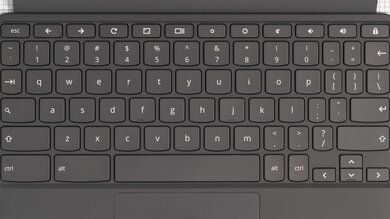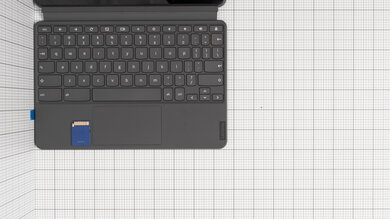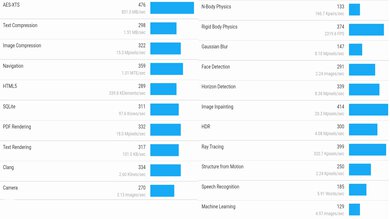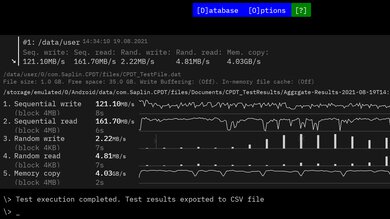The Lenovo Chromebook Duet (2020) is a budget 2-in-1 laptop that runs on Chrome OS. Its compact size is great for portability as it can easily fit into most bags, and its battery lasts nearly twelve hours of light productivity on a full charge. It has an ARM-based mobile SoC (System-on-Chip) that can handle simple tasks, but it's nowhere near powerful enough for demanding workloads. Also, you can't install x86 applications due to Chrome OS' limitations, which means you're limited to using web apps through the Chrome browser or Android and Linux apps. Unfortunately, the keyboard is tiring to type on, the touchpad is tiny, and the speakers sound bad. Also, it has a sub-par webcam and only a single USB-C port.
There are three models of the Lenovo Chromebook Duet. They all have the same CPU, GPU, and memory configuration; the only differences are the storage sizes and whether or not a stylus pen is included. Our unit has 64GB of storage, which should be enough for most people, but if you want a bit more headroom or want to install games from the Google Play Store, you might want to opt for 128GB. Our unit doesn't include a stylus pen, but you can get a 64GB model that does, and the 128GB model includes one by default.
Our Verdict
The Lenovo Chromebook Duet is okay for school use. Its compact size makes it easy to carry around, and its battery lasts well over a full day if you're mainly performing light tasks, like web browsing and text formatting. The screen is sharp but doesn't give a whole lot of space for multitasking. Unfortunately, the keyboard is tiring to type on, the touchpad is small and prone to accidental triggers, and it only has a single USB-C port.
- Very portable due to compact size.
- Excellent battery life.
- Only one USB-C port.
- Small keyboard is hard to type on.
- Webcam image is too dark.
The Lenovo Chromebook Duet is bad for gaming. It's a Chrome OS device that runs on a low-power ARM-based mobile SoC, so it can only run light Android games from the Google Play Store. Even then, some games aren't optimized for keyboard and touchpad input. Also, it has a 60Hz screen with no VRR support.
- Mobile SoC not powerful enough to handle demanding workloads.
- 60Hz screen with no VRR support.
- Can't run x86 applications.
- Hard to access internals for repairs; no user-upgradeable parts.
The Lenovo Chromebook Duet is decent for media consumption. It's very portable thanks to its compact size, and the battery life is excellent for video playback. The screen looks sharp and gets bright enough to combat glare in well-lit settings, but it isn't the best for dark rooms because it has a low contrast ratio that makes blacks appear grayish. It supports touch input so that you can watch in tablet mode without having to carry the keyboard around. The speakers sound pretty bad, and it also lacks a headphone jack. A USB-C to 3.5mm audio adapter is included in the box, but since it only has a single USB-C port, you can't charge the device or connect an external display while using wired headphones.
- Very portable due to compact size.
- Screen produces a sharp image due to high pixel density.
- Speakers sound bad and don't get very loud.
- Low contrast not ideal for dark rooms.
The Lenovo Chromebook Duet is bad for use as a workstation. You can't install any x86 applications because it's a Chrome OS device with an ARM-based mobile SoC, and it doesn't have enough processing power to handle demanding tasks like video editing or 3D rendering. It has a slow eMMC storage drive, a single USB-C port, and you can't upgrade any of the components after purchase.
- Mobile SoC not powerful enough to handle demanding workloads.
- Only one USB-C port.
- Can't run x86 applications.
- Hard to access internals for repairs; no user-upgradeable parts.
The Lenovo Chromebook Duet is sub-par for business use. Although it's very portable, its small screen size might make some tasks quite hard, like split-screen multitasking or working in a spreadsheet. On top of that, it runs on Chrome OS, which means you can't install any x86 applications. The keyboard feels cramped even for people with small hands, and the tiny touchpad is prone to accidental triggers. The webcam's video quality is disappointing, and its single USB-C port can only output a 720p signal to an external display. On the bright side, the battery lasts almost twelve hours of light productivity on a full charge.
- Very portable due to compact size.
- Excellent battery life.
- Only one USB-C port.
- Small keyboard is hard to type on.
- Can't run x86 applications.
- Webcam image is too dark.
Changelog
- Updated Mar 01, 2023: Added mention of the Lenovo Chromebook Duet 3 (2022) as an alternative with better performance in the Geekbench 5 section.
- Updated Nov 01, 2021: Review published.
Check Price
Differences Between Sizes And Variants
We tested the 10.1" Lenovo Chromebook Duet. The CPU, GPU, and memory aren't configurable. You can only choose between a model with 64GB or 128GB of storage. Our unit (part number ZA6F0031US) doesn't include a USI stylus, but you can get a 64GB model with one (part number ZA6F0072US), and the 128GB model (part number ZA6F0075US) includes one by default.
| CPU |
|
|---|---|
| GPU |
|
| Memory |
|
| Storage |
|
| USI Stylus |
|
Our display and performance results are only valid for the configuration that we tested. If you come across a different configuration option not listed above, or you have a similar Chromebook Duet that doesn't correspond to our review, let us know, and we'll update it. Some tests, like black uniformity and color accuracy, may vary between individual units.
You can see our unit's label here.
Popular Laptop Comparisons
The Lenovo Chromebook Duet (2020) and the Microsoft Surface Go 2 (2020) are both 2-in-1 ultraportable laptops with kickstands and detachable keyboards, but the Surface runs Windows, whereas the Lenovo uses Chrome OS. The Surface is better for most uses, with a better-feeling build, a display with more accurate colors, and a few more ports. Also, it has a better keyboard and touchpad, its speakers sound nicer, and its webcam and microphone are far superior. The Lenovo's battery lasts much longer, and although its MediaTek Heli P60T CPU performs better than the Pentium Gold on the Surface, you can get the Surface with a better-performing Intel m3 processor.
The Lenovo Chromebook Duet 5 (2021) is a larger and newer version of the Lenovo Chromebook Duet (2020). The most notable change is the display, as the Duet 5 sports a larger 13.3 inch OLED panel that delivers significantly better picture quality. The Duet 5 has a better webcam for video calls, better-sounding speakers, and its Qualcomm Snapdragon SoC provides a snappier desktop experience. The Duet 5's battery life is shorter than the original Duet's for productivity, but it lasts just as long for video playback and gaming.
The Lenovo Chromebook Duet 3 (2022) is a newer version of the Lenovo Chromebook Duet (2020). The 2022 model is slightly better. It has a faster SoC, a much better webcam, and a second USB-C port. The screen is a little bigger and brighter, but it isn't as accurate out of the box and doesn't handle reflections as well as the 2020 model.
The Acer Chromebook Spin 311 (2021) and the Lenovo Chromebook Duet (2020) are both 2-in-1 convertible laptops that you can also use in tablet mode. However, the Acer uses a 360-degree hinge that lets you flip the screen around, whereas the Lenovo has a kickstand and detachable keyboard. While the Lenovo's screen is smaller, it looks significantly sharper, brighter, and more colorful. The Acer's keyboard doesn't feel as cramped as the Lenovo's and provides a better typing experience. The Acer also has a larger touchpad and better port selection. CPU and GPU performance is about the same on both laptops; however, the Acer has a much longer battery life due to its larger battery capacity.
Test Results

The Lenovo Chromebook Duet is a 2-in-1 tablet with a detachable keyboard, similar to Microsoft's Surface Pro and Surface Go lineup. The most notable difference is that the kickstand is built into the back cover, which attaches to the back of the tablet magnetically. The tablet itself has a two-color scheme; Lenovo calls the two colors Ice Blue and Iron Gray. The back cover is covered in fabric to make it more comfortable to hold when using it as a tablet. Both the back cover and keyboard are included in the box. If you don't like the kickstand and detachable keyboard style of the Duet, and you prefer a 2-in-1 Chromebook with a 360-degree hinge, check out the Acer Chromebook Spin 311 (2021).
The kickstand's hinge is okay. There's enough resistance that you'll likely need two hands to open it, but that amount of resistance also makes it stable enough that you can type on the on-screen keyboard without much wobble. The 158-degree hinge range we posted is the maximum angle of the tablet when using the kickstand, but you can go further and lay it flat if you close the kickstand. You can't set the angle at less than 90 degrees because it would slam shut.
The Lenovo Chromebook Duet is a very compact device that fits easily into most bags. The measurements we posted are taken with the keyboard and back cover attached. The keyboard and back cover add quite a bit of bulk to the device, doubling the thickness; however, it's still a very portable device overall. Here are the measurements for the tablet itself:
- Thickness: 0.7cm
- Width: 23.9cm
- Depth: 15.9cm
- Volume: 266.007cm³
- Weight: 0.47kg
It's worth mentioning that 2-in-1 devices with a keyboard attachment and kickstand are usually not very lap-friendly. The keyboard can be unstable, and the screen can tip over easily because it's where most of the weight is. The Lenovo Chromebook Duet's compact size might also make it uncomfortable to use on a lap for some people.
The Lenovo Chromebook Duet isn't serviceable. We couldn't open it without risking severe damage to the tablet. We expect everything to be soldered on and non-upgradeable. Opening the tablet and making changes to the hardware may void the manufacturer's warranty.
While the Lenovo Chromebook Duet's full HD resolution isn't particularly impressive on paper, it does result in a very high pixel density on such a compact screen, so images and text still look very sharp. Its 16:10 aspect ratio gives you a bit more vertical space in landscape orientation, which means you don't have to scroll as much, and it also gives you more horizontal space when using it as a tablet in portrait mode so that it doesn't feel overly narrow. The bezels are pretty thick by current standards, but at the same time, they provide a place to hold onto in tablet mode. It's touch-sensitive, and it also supports USI (Universal Stylus Initiative) pen input. If you want a similar device with a larger display, check out the Lenovo Chromebook Duet 5 (2021).
The Lenovo Chromebook Duet has a basic 60Hz refresh rate with no VRR support, which is expected for a media consumption and light productivity device. As you can tell from the amount of ghosting in the motion blur photo, the response time is quite slow, so it isn't ideal for viewing fast-moving content.
Note: The horizontal stripes (moiré) in the photo are caused by the camera and aren't visible in person.
The Lenovo Chromebook Duet has an okay contrast ratio, typical of most IPS panels. It means blacks look grayish in dark environments. The round spot in the photo is a reflection of the camera lens, not a screen defect. Chromebooks have a built-in Content Aware Brightness Control feature, a type of adaptive brightness, but it doesn't seem to affect the checkerboard pattern that we use for testing. The contrast ratio can vary between individual units.
The Lenovo Chromebook Duet can get pretty bright, close to the advertised 400 cd/m². It's enough to combat glare in most settings, but visibility might still be a problem in direct sunlight. It gets very dim at the lowest brightness setting to reduce eye strain when viewing content in the dark. Like the Google Pixelbook Go (2019), the Content Aware Brightness Control doesn't seem to do much.
The Lenovo Chromebook Duet's reflection handling is decent. It can be hard to view dark scenes if there's a bright light shining on the screen, but it's not too bad when viewing well-lit scenes with the screen at max brightness.
The Lenovo Chromebook Duet has good horizontal viewing angles. The image remains accurate when viewed from the side, great for sharing the screen with someone else.
The vertical viewing angles are decent. The image remains accurate as long as you don't tilt the screen too far.
The Lenovo Chromebook Duet's out-of-the-box color accuracy is okay. Most colors are only slightly inaccurate, but white balance is visibly off. The color temperature is quite cool, which results in a blueish tint. The gamma doesn't quite follow the sRGB curve; most scenes are too bright, while dark scenes are too dark. Color accuracy can vary between individual units. If you want a laptop with a similar color gamut that displays much more accurate colors, check out the Acer Chromebook Spin 713 (2020).
The Lenovo Chromebook Duet has an excellent color gamut, with full coverage of the commonly-used sRGB color space. Its Adobe RGB coverage is great but likely too low for professionals working in that color space. Likewise, it has very good DCI P3 coverage, but not enough to provide a good HDR experience or for content creation. The Rec. 2020 coverage is sub-par, though very respectable for its class.
The Lenovo Chromebook Duet 10.1 has a disappointing keyboard. It feels cheap, and it's too small and cramped even for people with small hands, making it hard to adapt to. The keys are fairly stable, with a good amount of travel for a type cover keyboard, but they feel tiring to type on for extended periods. If you're looking for a similar 2-in-1 laptop that provides a better typing experience, check out the Microsoft Surface Go 2 (2020).
The Lenovo Chromebook Duet has a bad touchpad. It's small, and you can only click on about 3/4 of the touchpad. Palm rejection isn't very good, so it occasionally picks up accidental touches when typing. Also, it doesn't always respond to gestures, and dragging and dropping items doesn't work at times.
The Lenovo Chromebook Duet's speakers are bad. Although most laptop speakers lack bass, it's particularly noticeable in this case, so the overall sound is treble-heavy and slightly piercing. They also don't get very loud. If you want a Chromebook with better-sounding speakers, check out the HP Chromebook 14 (Intel Celeron N4000, 2021).
The webcam's video quality is sub-par. The image is too dark, causing a loss of fine details in the darker colors and shades. The microphone records good quality audio overall, but there's a lot of static in the voice. If you want a Chromebook with a better webcam, check out the Google Pixelbook Go (2019).
The Lenovo IdeaPad Chromebook Duet has a single USB-C port that supports video output with a maximum resolution of 720p, charging, and USB 3.2 Gen 2 (up to 10Gbps). A USB-C to 3.5mm audio adapter is included in the box because there's no headphone jack, but since there's only one port, you can't charge the device or connect an external display while using it for audio.
The Lenovo Chromebook Duet's wireless adapter is a Qualcomm Atheros Model L QCNFA324.
The Lenovo Chromebook Duet has a single CPU configuration, the MediaTek Helio P60T. It's a low-power ARM-based mobile SoC with four performance cores to handle demanding workloads and four efficiency cores to conserve power when performing simple tasks. It's powerful enough for light productivity like word processing, web browsing, and checking emails, but don't expect it to do heavy-lifting like video editing. It can handle most Android games from the Google Play Store except very graphically demanding ones.
The Mali-G72 MP3 is an integrated GPU in the MediaTek Helio P60T SoC. It can handle light tasks and most Android games from the Google Play Store, but it isn't powerful enough for demanding tasks, like 3D rendering, video editing, or graphically intensive games.
The Lenovo Chromebook Duet only comes with 4GB of RAM, and it isn't upgradeable. It's enough for light productivity tasks and media consumption, but you'll experience some slowdowns if you have a lot of Chrome tabs open at once or have many things running in the background.
There are two storage options, 64GB and 128GB; both are eMMC drives. 64GB should be enough for most people, but it might be worth getting the 128GB option just to have some headroom.
The Lenovo Chromebook Duet has a terrible score in the Geekbench 5 benchmarks, as expected for a device running on a low-power mobile SoC. We can't run the GPU compute test on our version of Geekbench 5 because it doesn't support the proper graphics API, though it's very likely that it'll perform poorly as well because it only has integrated graphics. If you want a similar laptop with better performance, check out the Lenovo Chromebook Duet 3 (2022).
Cinebench R23 doesn't work on Chrome OS. That said, we expect the CPU rendering performance to be poor.
We can run Blender through Linux on Chrome OS, but it can't detect the CPU or GPU. We're not sure why that is as it's a 64-bit SoC, though it's likely that Blender just doesn't support the MediaTek Helio P60T. As it's a low-power mobile SoC, we don't expect the performance will be sufficient for any practical purposes.
The Lenovo Chromebook Duet's storage performs poorly, with very slow read and write speeds, as is expected from an eMMC drive. However, the system still feels responsive because Chrome OS is a lightweight operating system, and most tasks are web-based. You'll likely only see slowdowns when loading a demanding game or transferring files. Unfortunately, the 128GB storage option is also an eMMC drive.
The Lenovo Chromebook Duet 2-in-1 has excellent battery life. Although it has a small battery capacity, it still manages to last well over a full workday of light productivity. It doesn't last as long for video playback, though, and even less if you play CPU or GPU-intensive games. Battery life can vary greatly depending on your usage.
Borderlands 3 doesn't run on Chrome OS. It's very unlikely that the Lenovo Chromebook Duet can maintain playable frame rates in such a graphically intensive game anyway.
Civilization VI doesn't run on Chrome OS.
CS:GO doesn't run on Chrome OS.
Shadow of the Tomb Raider doesn't run on Chrome OS.
The Lenovo Chromebook Duet has superb thermal and noise performance. It doesn't get very hot even though it's a fanless device, and since all the components are on the screen side, the heat doesn't extend to the keyboard. The heat from the screen isn't an issue when in tablet mode either. You can see the tablet's thermal imaging here.
We can't run the performance over time test because the software we use isn't compatible with Chrome OS. If there's performance loss, it'll only be noticeable if you're performing heavy, sustained workloads.
The Lenovo Chromebook Duet doesn't have any additional software other than those that typically come with Chrome OS. Chrome OS is a lightweight operating system designed to run web apps through a Chrome browser and Android apps from the Google Play Store. You can also run Linux apps within Chrome OS. However, you can't install any x86 applications coded for platforms like Windows or macOS without a third-party solution. If you need a similar 2-in-1 device that can run x86 programs, check out the Microsoft Surface Go 3 (2021).
Every Chromebook has an 'expiration date' at which it stops receiving software updates, and according to Google's official document, the Chromebook Duet's end-of-life is June 2028. Google may extend this date as they have in the past for other Chromebooks; it's best to check their official document for any changes.
Our Lenovo Chromebook Duet doesn't have any extra features, but you can get a model that comes with a USI (Universal Stylus Initiative) stylus for pen input. Even if you get a model that doesn't include one, it'll work with any USI stylus.



